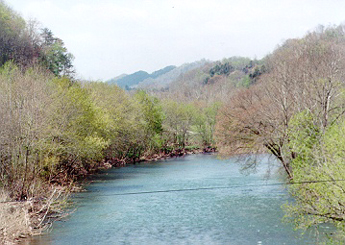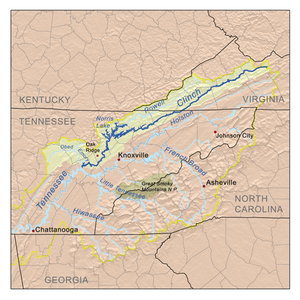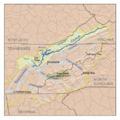Clinch River facts for kids
Quick facts for kids Clinch River |
|
|---|---|

The Clinch River at Speers Ferry in Scott County, Virginia
|
|

Clinch River watershed
|
|
| Country | United States |
| State | Virginia, Tennessee |
| Physical characteristics | |
| Main source | Buckhorn Mountain near Tazewell, Virginia 2,760 ft (840 m) 37°08′29″N 81°27′41″W / 37.14139°N 81.46139°W |
| River mouth | Tennessee River at Kingston, Tennessee 741 ft (226 m) 35°51′48″N 84°31′54″W / 35.86333°N 84.53167°W |
| Length | 337 mi (542 km) |
| Basin features | |
| Basin size | 4,413 sq mi (11,430 km2) |
| Tributaries |
|
The Clinch River is a long river in the United States. It starts near Tazewell, Virginia, and flows for over 300 miles (480 km). The river travels southwest through a large valley called the Great Appalachian Valley. Along its journey, it collects water from many smaller streams, called tributaries. One important tributary is the Powell River. The Clinch River finally joins the Tennessee River in Kingston, Tennessee.
Contents
River's Path
The Clinch River has two dams built on it. The first is Norris Dam. This was the very first dam built by the Tennessee Valley Authority (TVA). The TVA is a special government agency that helps manage rivers and power in the region.
The second dam is the Melton Hill Dam. This dam is unique because it has a navigation lock. A navigation lock is like a water elevator for boats. It helps boats move between different water levels. This is the only TVA dam with a lock that is not directly on the main Tennessee River.
The Powell River is a major stream that flows into the Clinch River. The areas where the Clinch and Powell rivers collect water are separated by Powell Mountain. Other smaller streams like Coal Creek and Beaver Creek also join the Clinch River.
River's History
A special place called Southwest Point is located where the Clinch River meets the Tennessee River. This area was once home to an important early fort. It has been rebuilt so people can visit it today. This spot was very important to Native Americans for a long time.
A peace agreement, or treaty, was signed here between the Cherokee people and white settlers. This treaty allowed the capital city of Tennessee to be moved to Southwest Point. The state government did meet in Kingston for one day, but then decided to move the capital somewhere else.
How the River Got Its Name
The name "Clinch" comes from an explorer who visited the area in the 1700s. Old maps show different spellings like "Clinch's River" or "Clenches River."
There's also a fun story about the name. People say a pioneer fell into the river and shouted, "Clinch me! Clinch me!" This supposedly meant "grab me" or "hold me tight."
An even older name for the river was "Pelisipi River." This name was thought to mean "winding waters" in the Cherokee language. You can still see the name "Pellissippi" used today in places like Pellissippi Parkway and Pellissippi State Community College.
Power Plants on the River
There are a few power plants along the Clinch River. One is at Carbo in Russell County, Virginia. It was built in 1957 and used to burn coal. In 2016, it was changed to use natural gas instead. Another power plant, the Virginia City Hybrid Energy Center, is nearby. It started working in 2012 and also helps provide electricity.
Environmental Concerns
The Clinch River is home to many rare animals, especially mussels. These are shellfish that live in the river. Sadly, pollution from mining in the area has caused problems for these animals. Many mussels died out in the 1900s. But in the early 2000s, some mussels were brought back to the river to help their populations grow again.
In 2008, there was a big accident at the TVA's Kingston Fossil Plant. A lot of fly ash spilled into the lower part of the river. Fly ash is a leftover material from burning coal. This spill put millions of pounds of ash into the water. The Environmental Protection Agency (EPA) helped clean up the ash. Studies after the spill showed that the river had higher levels of metals like mercury and arsenic.
River Life
The Clinch River is a great place for fish. Above Clinton, Tennessee, the river is stocked with rainbow trout and brown trout. This means that the Tennessee Wildlife Resources Agency adds these fish to the river for people to catch.
Before dams were built, the Clinch River was famous for its freshwater mussels and pearls. The rivers in the southern Appalachian Mountains still have many different kinds of mussels. Mussels were an important food source for Native Americans. Later, settlers used them as bait for fishing and even as food for hogs.
The freshwater pearl industry was very big in this area in the late 1800s and early 1900s. The Clinch River was a key place for finding pearls. However, when the TVA built dams like Norris Dam, they flooded many areas where mussels lived. This caused the pearl industry to decline.
Fun Activities
There are several parks along the Clinch River where you can enjoy nature. These parks are located in both Tennessee and Virginia.
Some state parks in Tennessee include:
- Big Ridge State Park
- Norris Dam State Park
- Chuck Swan State Forest
Images for kids
-
The Clinch River at Speers Ferry in Scott County, Virginia
See also
 In Spanish: Río Clinch para niños
In Spanish: Río Clinch para niños



